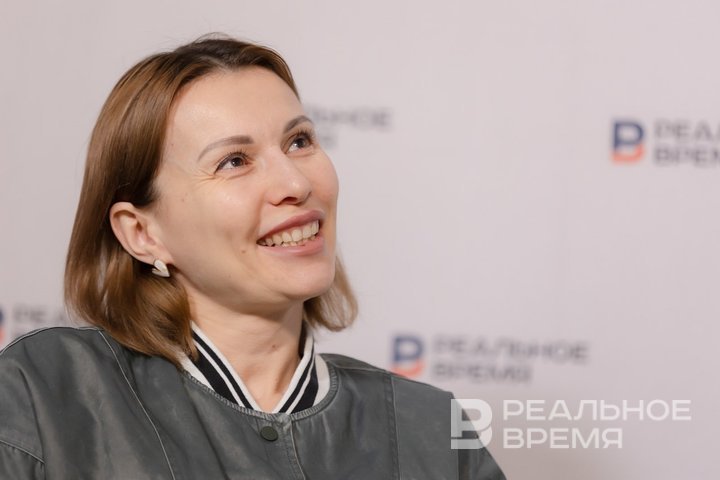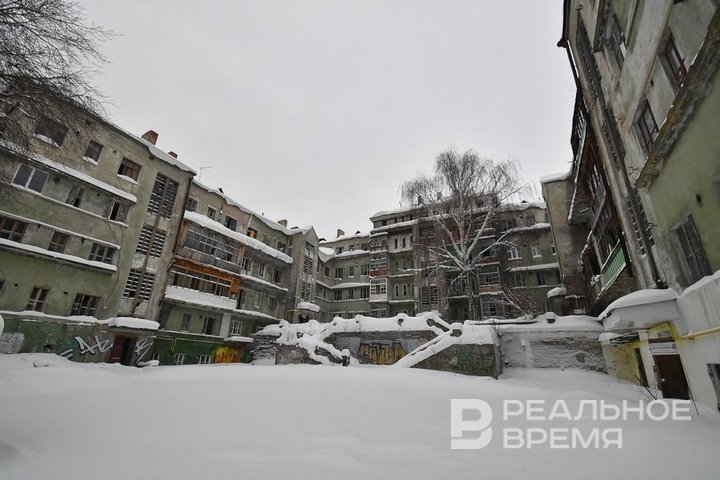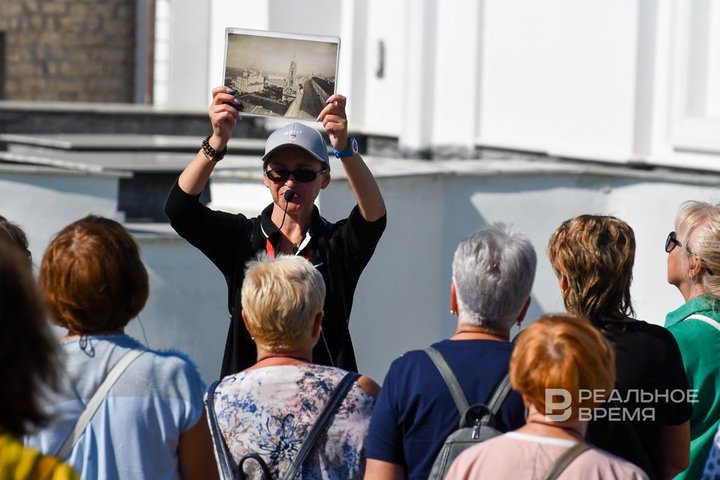Zilya Safina: ‘Antique tiles that can be washed with water to reveal their beauty are part of the charm’
How the author of a blog about unpopular places in Tatarstan turned walks with children into excursions

Tatarstan is famous for its attractions, such as the Kazan Kremlin and the island-town of Sviyazhsk, which attract more and more tourists every year. But the capital of Tatarstan has a downside — these are unpretentious and sometimes abandoned places that attract a limited circle of people who appreciate ancient architecture and history. “For me, antique tiles that can be washed with water to reveal their beauty are part of the charm. But the average person might be scared or find such a place unpleasant,”” says Zilya Safina, the author of a blog about unpopular places in Tatarstan. In an interview with Realnoe Vremya, she told us how she came to social networks, named unusual places for walks and outlined trends in the excursion services market.
“Maternity leave became a period of rethinking my life for me”
Please, tell us how it all began?
The blog started completely by accident, when I was 32 and found myself on my second maternity leave and was not familiar with social media. One night, while my son was sleeping, I downloaded the first social network and was amazed by the new world. I found old friends and learned about their lives.
The first entry was about the New Year tree. As the children grew, walks in the same yard became boring. New parks, playgrounds, and places appeared in Kazan that we wanted to show the children. That’s how our exploration of the city began.
My first serious trip was visiting the Temple of All Religions, which is 11 kilometres from my home. I was afraid that the gas would run out or something would happen to the car, but we managed, and this was the beginning of discovering new places.
How did you come to create a blog and why did you choose the topic of unusual places in Tatarstan? What was the turning point in your perception of the city?
Maternity leave became a period of rethinking my life for me. I realized that, despite living in Kazan for many years, I did not know my city. It turns out that even in neighbouring areas there are amazing places with history and interesting people. This became an incentive for research.
Our trips became longer and more interesting, I wanted to show the children not only playgrounds, but also tell them about the history of the city. The Internet allows you to quickly find information on Wikipedia or delve into YouTube and social media feeds. It is addictive.

Now I am interested in history, architecture, details hidden behind facades. My blog is focused on the history and culture of abandoned and little-studied locations. Such content is less popular, but I consider it a qualitative transition. These are no longer just beautiful pictures, but deep research and stories.
Most of the places you talk about are abandoned. People try to avoid them. I wonder how many people want to go to such places? Are there any foreigners among them? It is worth considering that Kazan is a centre of attraction for tourists.
I have several foreign subscribers who actively respond to the content: they like it, write comments. However, they do not show much interest in abandoned locations, preferring beautiful, ceremonial places, such as the Kremlin or modern landmarks. Abandoned places attract a limited circle of people who appreciate ancient architecture and history. These could be local historians, history buffs or those who understand architectural details. For me, old tiles that can be washed with water to reveal their beauty are part of the charm. But the average person might be scared or find such a place unpleasant. Therefore, this is a specific audience that either likes such locations or not. Most people prefer gloss and beauty. Even ordinary administrative buildings, such as the Social Fund office in the center of Kazan, can be of greater interest to the general public.

“Despite all the difficulties, the Mergasovsky House is unique”
In January, you talked about the Mergasovsky House — it is one of the most famous abandoned buildings in Kazan. Like, this is the only house that you yourself are afraid to enter. Why?
The Mergasovsky House evokes special feelings in me, because I mostly explore pre-revolutionary buildings. When you enter such buildings, you immediately feel their quality and reliability. I trust buildings built before the revolution. It’s as if I’m having a heart-to-heart dialogue with them — it’s as if I’m communicating with them. I understand that these houses are built to last for centuries from quality materials. This is a different civilization, a different approach to construction.
And when you approach the Mergasovsky House, you don’t even need to go inside. Just look at the balconies and concrete slabs that are crumbling right before your eyes. The reinforcement is sticking out, the concrete is crumbling. You see, this is not a consequence of blows are the result of poor construction.
The house was built in 1928, that is, 11 years after the revolution and civil war. At that time, the country was in deep ruin — hunger, economic crisis, all resources were at their limit. After the change of regime, the country was recovering, but the construction of that time often suffered from a lack of funds. This is evident not only in the case of the Mergasovsky House, but also in many other buildings of those years.
When I began to study this issue more deeply, it became obvious that the construction of that time could not be of high quality. Even without additional sources of information, this is clear — the conditions were extremely difficult. And that is why I am afraid to go into the Mergasovsky House: I understand that the structure is unstable, the materials are of poor quality, and this causes a tangible feeling of anxiety.
The slabs in the Mergasovsky House were made of a pressed mixture with the addition of reeds and cement — this was an experimental material that turned out to be extremely short-lived. Can you imagine, the house was built without taking into account basic engineering requirements: even the heating system was not included in the project! As a result, the walls had to be cut through after the construction was completed to install utilities. It is not surprising that the house cracked just a month after it was handed over. It is now almost a hundred years old, and its condition is deplorable. Of course, I understand those who conduct tours there, but personally, I am afraid to go inside. All the structures — walls, ceilings, floors — are in critical condition.
The house really looks monumental, although in fact it is very fragile. I love such houses, especially those that reflect the ideology of their time.

Yes, the house is truly authentic. Young people constantly climb in there, take pictures. Although the local authorities tried to restrict access by installing fences, it did not help.
Absolutely right. I myself have been inside and I can say that this place is unique. The Mergasovsky house is the only one of its kind in Kazan. It attracts people even in such a neglected state.
“Don't start with obvious places like the Palace of Agriculturists”
What other interesting places in Kazan or its surroundings are worth visiting? Maybe you should tell us about other attractions in the nearby areas?
Don't start with obvious places like the Palace of Farmers, which I call “the cheapest canteen in the city.” I suggest paying attention to places that I find especially interesting.
I recently made a short video about 11 ancient mosques in Kazan. Even if you are not a Muslim, this is not a reason to refuse to visit these beautiful places. Many mosques are located nearby, which makes it easy to plan a route.
The Azimov Mosque, hidden in the depths of the New Tatar Settlement, is one of the most beautiful in the city. It was built by workers, and the authorship is still unknown. The stained glass windows of the mosque create a unique atmosphere, and the sunlight creates light effects on the walls. Guests are treated loyally here, it is enough to wear a headscarf. The entrance is open at any time, except for Friday prayers.
The Oleshkevich House on Mushtari Street is one of the few remaining Art Nouveau houses in Kazan. This quirky, asymmetrical house is decorated with a fantastic animal on the balcony, which resembles a toad or a lizard. There is now a medical facility inside, so the interior has not survived, but the facade is worth seeing. The house is located near the centre and is easy to find while walking through the historical districts.
Don't forget about the monasteries and churches of Kazan, such as the Assumption Zilantov Convent. A special place is occupied by the Chapel of Panteleimon the Healer, built with funds from Alafuzov and decorated with a beautiful turret.
The area near the Rowing Sports Centre is another great place for a walk. After the sports facilities and hotels, you can stroll along the embankment of the Kaban River, where in the summer there is a calm atmosphere and a bridge to the island. A walk along the Kaban behind the summer cottages will give you privacy.
Now about the places outside Kazan. For example, the famous glass beach in Zelenodolsk District.
The waste from the plant that once created this “glass” effect is gradually disappearing, and the area is not landscaped. The descent to the beach and the approach to it are quite difficult, so it is better to have shoes with good soles.
This place is more suitable for lovers of unusual adventures than for a classic holiday. But if you want to see something non-standard, it is definitely worth a visit. When I went there with my children, they were very surprised: “Where are we going? What is a glass beach?” They liked it, although the road took a long time. In general, this is an interesting corner of nature on the banks of the Volga. The children were surprised and interested.
“I don’t like it when legends prevail instead of facts in excursions”
I would like to talk about the excursion services market. Where do you think this sphere is heading? What trends are currently forming among tourists?
Previously, the profession of a tour guide was the lot of people with the relevant education. Now bloggers are actively developing this niche. I understand that there is a share of amateurism here, but the process of natural selection in the market will leave only those who offer a high-quality and creative product. Plus today there are many reviews of various excursions.
Changes in the excursion services market cannot go unnoticed. People are increasingly interested not only in traditional attractions, but also in lesser-known locations. This opens up new opportunities for business development, but requires a special approach to creating routes.

There is a boom in the tour guide market, especially in tourist cities such as Kazan. This is due to the development of domestic tourism due to restrictions on travel abroad. We began to discover the beauty of our country
I am positive about the emergence of many tour guides, the main thing is that the excursions are interesting, high-quality and affordable. This contributes to the development of domestic tourism and helps to form a love for your country. You can criticize the lack of education of tour guides, but if they offer a quality product, why not?
Sometimes the quality leaves much to be desired, I don’t like it when legends prevail in excursions instead of facts. For a blogger, artistic license is possible, but for a tour guide, facts are more important. It is important that over time, only those who can tell the history of a city in an interesting and reliable way remain. Despite possible shortcomings, the most important thing is that we awaken interest in our country and cities, which is wonderful! Let this trend continue to develop.
What advice would you give to beginning tour guides or bloggers who want to awaken interest in our city and republic? Where should they start? Maybe you can give some practical advice?
The main thing is to love your business. Work without love will not bring quality results. As a person who created her own dance school, I can confirm the correctness of this statement. I am happy to do what I love, and I also have hobbies and blogs.

I do not do advertising, earning money in other ways. For those who want to start developing in blogging or tour guiding, love for the business should come first. If the main goal is to make money, this is a disastrous decision.
People always see how a person treats their business, be it a blog or a service. The energy of successful bloggers or tour guides attracts an audience.
Love your business, be creative, try new things and don't be afraid of mistakes. Fear often gets in the way, but don't be afraid to ask for help or share ideas. Find your business and enjoy it. Many people still work at jobs they don't like, instead of doing what they love. Study, think and be creative!
Reference
*the social media banned in Russia
Tatarstan
